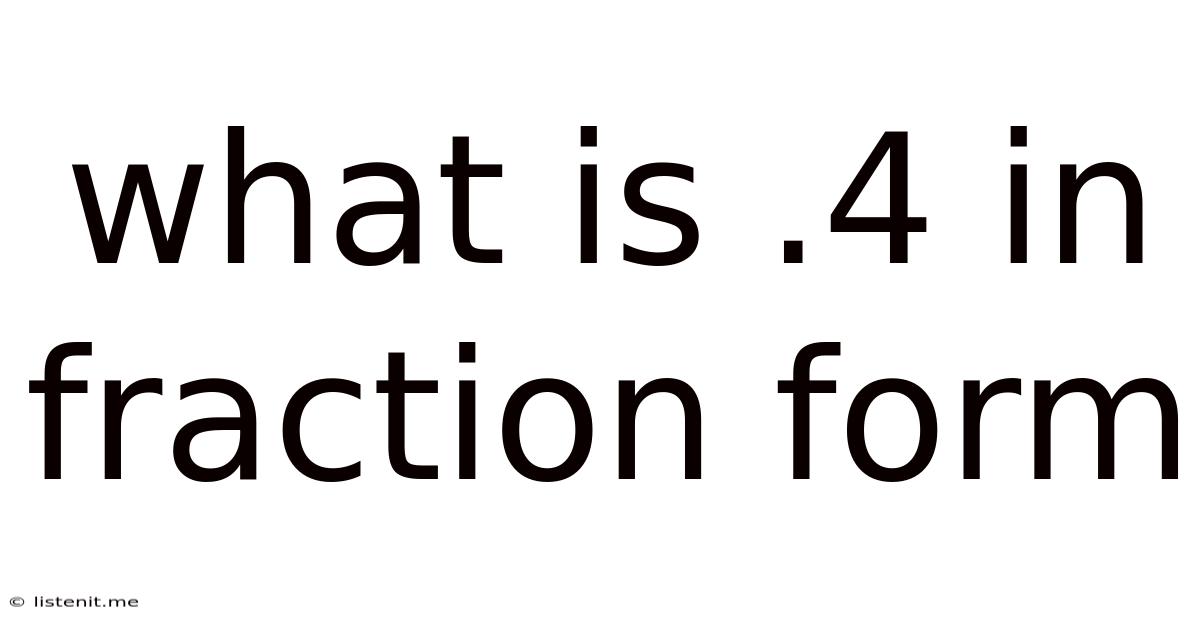What Is .4 In Fraction Form
listenit
May 09, 2025 · 4 min read

Table of Contents
What is 0.4 in Fraction Form? A Comprehensive Guide
Understanding decimal-to-fraction conversions is a fundamental skill in mathematics. This comprehensive guide will delve into the process of converting the decimal 0.4 into its fractional equivalent, exploring various methods and providing practical examples to solidify your understanding. We’ll also touch upon the broader context of decimal-fraction conversions and their applications.
Understanding Decimals and Fractions
Before diving into the conversion, let's briefly revisit the concepts of decimals and fractions.
Decimals: Decimals represent parts of a whole number using a base-ten system. The decimal point separates the whole number part from the fractional part. Each digit to the right of the decimal point represents a power of ten (tenths, hundredths, thousandths, and so on). For example, 0.4 represents four-tenths.
Fractions: Fractions represent parts of a whole using a numerator (the top number) and a denominator (the bottom number). The numerator indicates the number of parts, and the denominator indicates the total number of equal parts the whole is divided into. For example, ⁴⁄₁₀ represents four out of ten equal parts.
Converting 0.4 to a Fraction: The Core Method
The most straightforward method for converting 0.4 to a fraction involves recognizing the place value of the decimal digit.
Step 1: Identify the Place Value:
The digit 4 in 0.4 is in the tenths place. This means that 0.4 represents 4 tenths.
Step 2: Write the Fraction:
We can express 4 tenths as a fraction: ⁴⁄₁₀
Step 3: Simplify the Fraction (If Necessary):
This fraction can be simplified by finding the greatest common divisor (GCD) of the numerator (4) and the denominator (10). The GCD of 4 and 10 is 2. Dividing both the numerator and denominator by 2, we get:
⁴⁄₁₀ = ²⁄₅
Therefore, 0.4 in fraction form is ²/₅.
Alternative Methods for Decimal to Fraction Conversion
While the above method is the most direct, let's explore alternative approaches to reinforce the concept and enhance your understanding.
Method 2: Using the Power of 10
This method involves writing the decimal as a fraction with a denominator that is a power of 10. Since 0.4 has one digit after the decimal point, we'll use 10 as the denominator.
-
Step 1: Write the decimal as a fraction: ⁴⁄₁₀
-
Step 2: Simplify the fraction: As shown previously, this simplifies to ²⁄₅
Method 3: Understanding the Concept of Equivalence
Remember that fractions represent ratios. Finding equivalent fractions involves multiplying or dividing both the numerator and denominator by the same number without changing the overall value.
For instance, we can verify our result by finding an equivalent fraction:
²⁄₅ * ²⁄₂ = ⁴⁄₁₀
Multiplying both numerator and denominator by 2 gives us ⁴⁄₁₀, which is equivalent to 0.4. This confirms that ²⁄₅ is the correct simplified fraction.
Practical Applications of Decimal-to-Fraction Conversions
The ability to convert decimals to fractions is crucial in various mathematical contexts and real-world applications. Here are a few examples:
-
Baking and Cooking: Many recipes use fractions to specify ingredient quantities. If a recipe calls for 0.4 cups of sugar, you'd need to convert it to ²⁄₅ of a cup for accurate measurement.
-
Engineering and Construction: Precision is paramount in these fields. Converting decimal measurements to fractions ensures accuracy in blueprints and calculations.
-
Finance: Understanding fractions is essential for calculating interest rates, shares of ownership, and other financial computations. Decimals are often used in financial statements, but converting them to fractions can provide a clearer understanding of the proportional relationships.
-
Data Analysis: When working with data that involves proportions or percentages, understanding the relationship between decimals and fractions is essential for accurate analysis and interpretation.
Beyond 0.4: Converting Other Decimals to Fractions
The principles discussed above apply to converting other decimals to fractions. Let's look at a few more examples:
-
Converting 0.25 to a fraction:
- 0.25 has two digits after the decimal point, so we use 100 as the denominator: ²⁵⁄₁₀₀
- Simplifying this fraction (GCD of 25 and 100 is 25): ²⁵⁄₁₀₀ = ¹⁄₄
-
Converting 0.125 to a fraction:
- 0.125 has three digits after the decimal point, so we use 1000 as the denominator: ¹²⁵⁄₁₀₀₀
- Simplifying this fraction (GCD of 125 and 1000 is 125): ¹²⁵⁄₁₀₀₀ = ¹⁄₈
-
Converting 0.666... (repeating decimal) to a fraction:
Repeating decimals require a slightly different approach. This is beyond the scope of this basic guide, but involves using algebraic manipulation to solve for the fractional representation.
Advanced Considerations: Recurring Decimals
Recurring decimals, like 0.333... (⅓) or 0.666... (⅔), cannot be expressed as a simple fraction with a finite denominator. These require specific techniques involving algebraic manipulations to convert them into their fractional equivalents.
Conclusion: Mastering Decimal-to-Fraction Conversions
Converting decimals to fractions is a vital skill with broad applications. By understanding the underlying principles and applying the methods outlined in this guide, you'll confidently navigate these conversions and enhance your mathematical proficiency. Remember that practice is key to mastering this skill, so try converting various decimals to fractions to reinforce your understanding. This will build a strong foundation for more advanced mathematical concepts and problem-solving. The ability to seamlessly switch between decimal and fractional representations will prove invaluable in numerous academic and real-world scenarios.
Latest Posts
Latest Posts
-
Calculate The G Rxn Using The Following Information
May 09, 2025
-
What Is Boiling Point In Kelvin
May 09, 2025
-
In Some Cells Mitosis Occurs Without Cytokinesis
May 09, 2025
-
1 To The Power Of 8
May 09, 2025
-
Differentiate Between Cell Wall And Cell Membrane
May 09, 2025
Related Post
Thank you for visiting our website which covers about What Is .4 In Fraction Form . We hope the information provided has been useful to you. Feel free to contact us if you have any questions or need further assistance. See you next time and don't miss to bookmark.